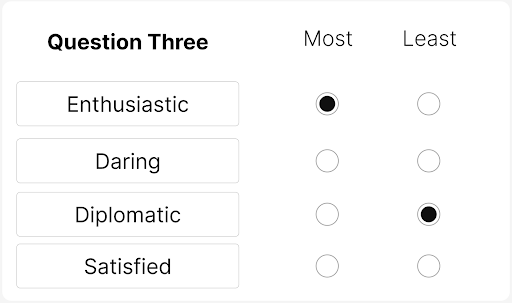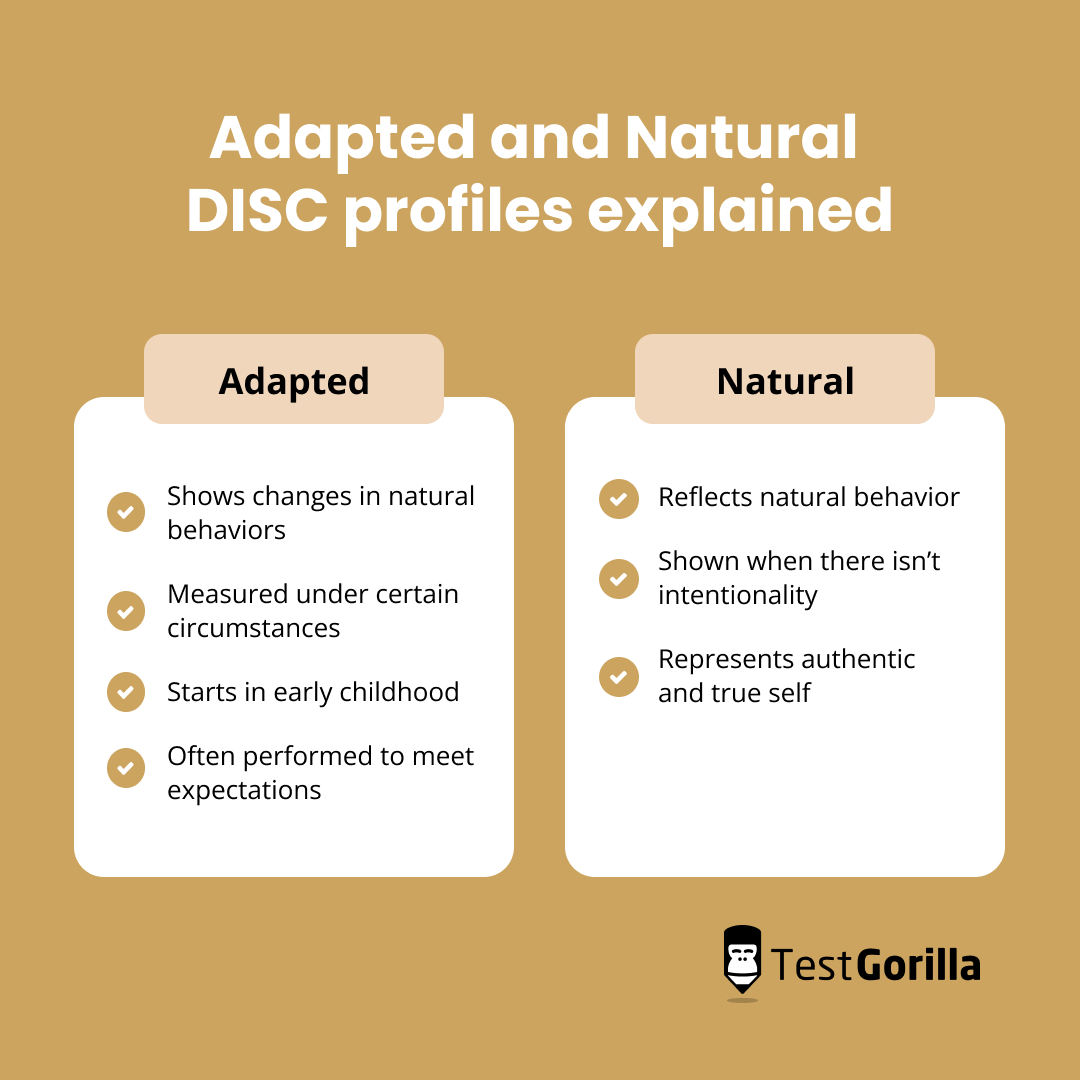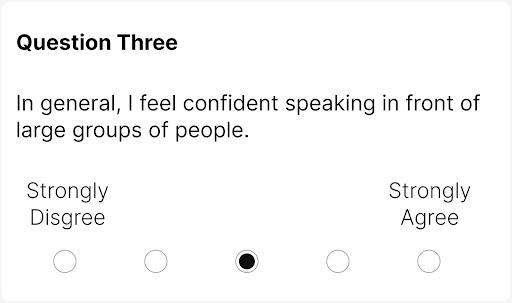A DISC test is a personality assessment that measures four primary personality traits: Dominance, Influence, Steadiness, and Conscientiousness.
In early versions of the DISC test, results were given in three graphs or profiles: Graph I, also called the “Adapted” profile, Graph II, also called the “Natural” profile, and Graph III, which combined the two.
The theory was that the “Natural profile” reflected your genuine behavioral style, whereas the “Adapted profile” showed how you consciously change your behavior.
Assessment techniques have evolved significantly since then, however, and researchers have largely moved away from this style of DISC testing. Today, modern DISC tests provide organizations with more reliable, actionable results.
In this article, we take a closer look at Natural and Adapted profiles and the controversial science behind them, as well as recent advancements made to DISC testing.
Table of contents
What are “Natural” and “Adapted” DISC profiles?
DISC tests identify people’s behavioral styles, showing alignment with each of the DISC behavioral styles: Dominance, Influence, Steadiness, and Conscientiousness.
DISC tests that offer Natural and Adapted profiles attempt to identify contrasting aspects of people’s behavioral traits.
Natural DISC profiles
A Natural DISC profile is said to reflect an individual’s natural behavioral style. That is, how they conduct themselves when they aren’t intentionally behaving in a particular way. A person’s Natural DISC profile was meant to represent their “authentic” or “true” self.
But we also actively change some aspects of our behavior. This is where Adapted DISC profiles were meant to come in.
Adapted DISC profiles
Adapted DISC profiles were intended to show how an individual changes their natural behavior under certain situations.
Most people learn how to adapt their behavior in early childhood and continue to do it throughout their lives. We often do it to meet social expectations and norms, such as those in professional settings.
What are the benefits of Natural and Adapted DISC profiles?
The belief was that, by comparing Natural and Adapted DISC profiles, employers would have a “more complete” picture of people’s behavior and which of those behaviors came to them naturally.
Everyone adjusts how they behave at work to an extent, but maintaining a different behavior style over time is demanding and can lead to stress. Therefore, it’s usually better to place people in positions that suit their natural behavioral tendencies.
In the past, it was argued that a significant difference between a person’s Natural and Adapted profiles would make them more likely to experience exhaustion or stress. Knowing this, managers, recruiters, and business owners could provide additional support or place them in an environment better suited to their “Natural” traits.
What’s the science behind “Adapted” and “Natural” DISC profiles?
To understand where Adapted and Natural profiles come from, let’s first look at how early DISC tests worked.
When someone takes this type of DISC test, they’re given four adjectives or descriptions and asked to choose the one that describes them the best and the one that describes them the least. You can see an example of this in the image below.
An example of a forced-choice question, like one that might appear on an early DISC test. © TestGorilla
This type of assessment technique is called “ipsative” or “forced-choice,” because test-takers don’t have the opportunity to describe just how “daring” or “diplomatic” they are. It’s a “yes or no” type of scenario.
After making around 28 of these choices, the words selected as “Most like me” give rise to the candidate’s Adapted profile. The idea is that people put more thought into their answers when asked to define what they are like instead of what they’re not like. Therefore, according to supporters of the Adapted profile, these answers are “less natural.”
The Natural profile is obtained by doing the opposite. Whatever words people say are least like themselves, the opposite trait is scored higher. For example, Daringness reflects Dominance but not Steadiness. A test-taker who says Daring describes them the least will have a higher Steadiness score (and a lower Dominance score).
If that sounds confusing, don’t worry – you’re not alone. Part of the reason modern DISC assessments no longer use this method is that the results aren’t as intuitive.
What are Natural and Adapted DISC graphs?
Test-takers receive their natural and adapted profiles in the form of DISC profile graphs. These are typically line graphs that display individuals’ traits across each DISC behavioral style, like in the example below.
An example of Natural and adapted DISC graphs © TestGorilla
How dependable are Natural and Adapted DISC profiles?
Like all DISC tests, tests that provide Natural and Adapted profiles stem from the work of psychologist William Moulton Marston. Whereas Marston did mention “natural and adapted behavior” in his writing, research on the effectiveness of Natural and Adapted DISC profiles is very limited.
The lack of research-backed data on Natural and Adapted profiles leaves two important questions unanswered:
Do Natural and Adapted profiles actually show people's natural and adapted behavior styles? With such little data, this is difficult to determine. Neither the British Psychological Society nor the Chartered Institute of Personnel, Training & Development (CIPD) support forced-choice tests in recruitment processes. In fact, almost all reputable, modern DISC assessments have abandoned this method. Natural profiles claim to reveal people’s “unconscious” behavioral traits, but people might give what they think are the best responses, not their true responses. This would mean that they don’t always reflect natural behavior.
If Natural and Adapted profiles do show natural and adapted styles of behavior, just how accurate are they?
Critics say that Natural and Adapted DISC profiles show only people’s perceptions of themselves. If this is true, the results from people with little self-awareness might be inaccurate.
Furthermore, having to choose from only four adjectives could be too limiting. People who take a Natural vs. Adapted DISC test might find that none of the options reflect their true feelings or behaviors. But, they must answer to move on and finish. This could unintentionally skew their results. Plus, as we’ve seen, forced-choice tests don’t allow for any nuance in one’s answers. A Likert-style test (where test-takers are asked to rank statements) gives greater freedom, which better reflects reality for most of us.
With so many questions around the validity of Natural and Adapted DISC profiles, it’s unsurprising that most platforms no longer support this style of testing. In fact, authoritative institutions abandoned it in the early 2000s.
A better approach: Modern DISC assessments
Our understanding of human behavior and behavioral testing has come a long way since the introduction of Natural and Adapted profiles.
In the 2000s, DISC test providers began replacing forced-choice questions with Likert scales. You’ve probably seen these before: Test-takers are asked to rank how much they agree or disagree with a statement, usually on a scale from 1 to 5. Likert scales increase reliability by allowing for greater nuance, resulting in more insightful test results.
Check out an example of a Likert-scale question below.
An example of a “Likert scale” questionnaire used in modern DISC assessments. © TestGorilla
When candidates take the TestGorilla DISC Personality test, they’re presented with 48 statements, one at a time. Each statement asks them to select how accurately it describes them from options on a five-point Likert scale.
One of the biggest benefits of all of TestGorilla’s tests is their ability to streamline your hiring process. In line with this, we present your DISC Personality test results in clear and concise language.
This means you don’t have to waste time deciphering numerous graphs to determine whether a candidate is likely to be a good fit for your team or company culture.
As soon as a candidate finishes their assessment, you’ll get a comprehensive report of their behavioral tendencies, including their:
Behavioral style
Behavior in relationships
Behavior at work
Best attributes
Main challenges
In addition, you’ll receive detailed explanations and suggestions to help you make the best decision.
We always recommend combining individual tests to assess your potential employees comprehensively. For instance, you might combine our DISC Personality Test with our motivation test if you’re worried about candidates’ being less than truthful.
By combining just two or three assessments, you can achieve a much clearer picture of your candidates than was ever possible with Natural and Adapted profiles.
Conclusion
Choosing the best candidates can be challenging, so gaining insights into their genuine behavioral tendencies is undoubtedly beneficial.
Natural and Adapted profiles are a useful concept, but the technique used to create them is outdated. Modern DISC tests use a proven method of evaluating behavior and defining personality traits that give much more accurate results.
TestGorilla’s DISC Personality test gives a much fuller, scientifically validated overview of your candidates’ behavior. Explore our similar personality and culture free tests when you sign up for a free plan.
Related posts
Hire the best candidates with TestGorilla
Create pre-employment assessments in minutes to screen candidates, save time, and hire the best talent.
Latest posts
The best advice in pre-employment testing, in your inbox.
No spam. Unsubscribe at any time.

Hire the best. No bias. No stress.
Our screening tests identify the best candidates and make your hiring decisions faster, easier, and bias-free.
Free resources
This checklist covers key features you should look for when choosing a skills testing platform
This resource will help you develop an onboarding checklist for new hires.
How to assess your candidates' attention to detail.
Learn how to get human resources certified through HRCI or SHRM.
Learn how you can improve the level of talent at your company.
Learn how CapitalT reduced hiring bias with online skills assessments.
Learn how to make the resume process more efficient and more effective.
Improve your hiring strategy with these 7 critical recruitment metrics.
Learn how Sukhi decreased time spent reviewing resumes by 83%!
Hire more efficiently with these hacks that 99% of recruiters aren't using.
Make a business case for diversity and inclusion initiatives with this data.




















